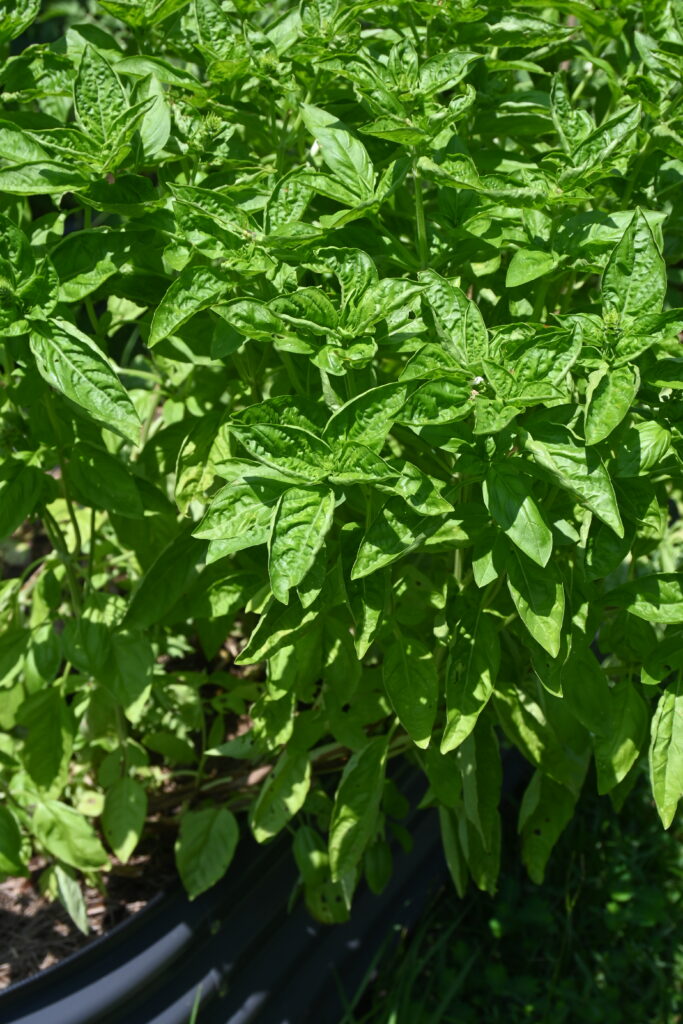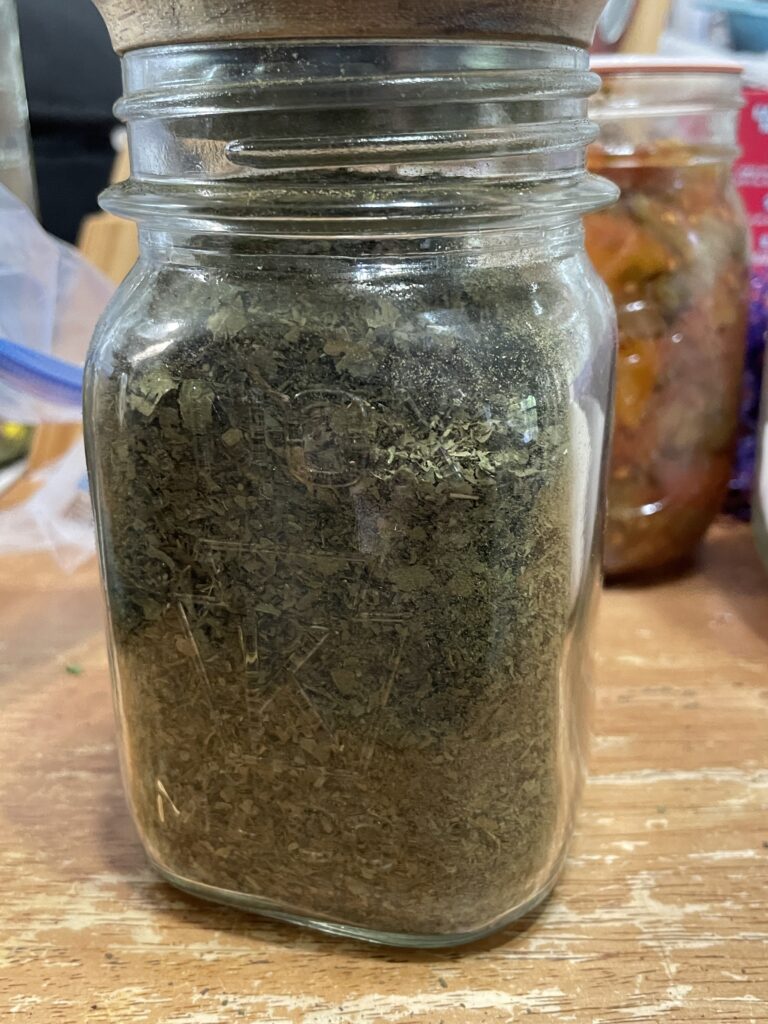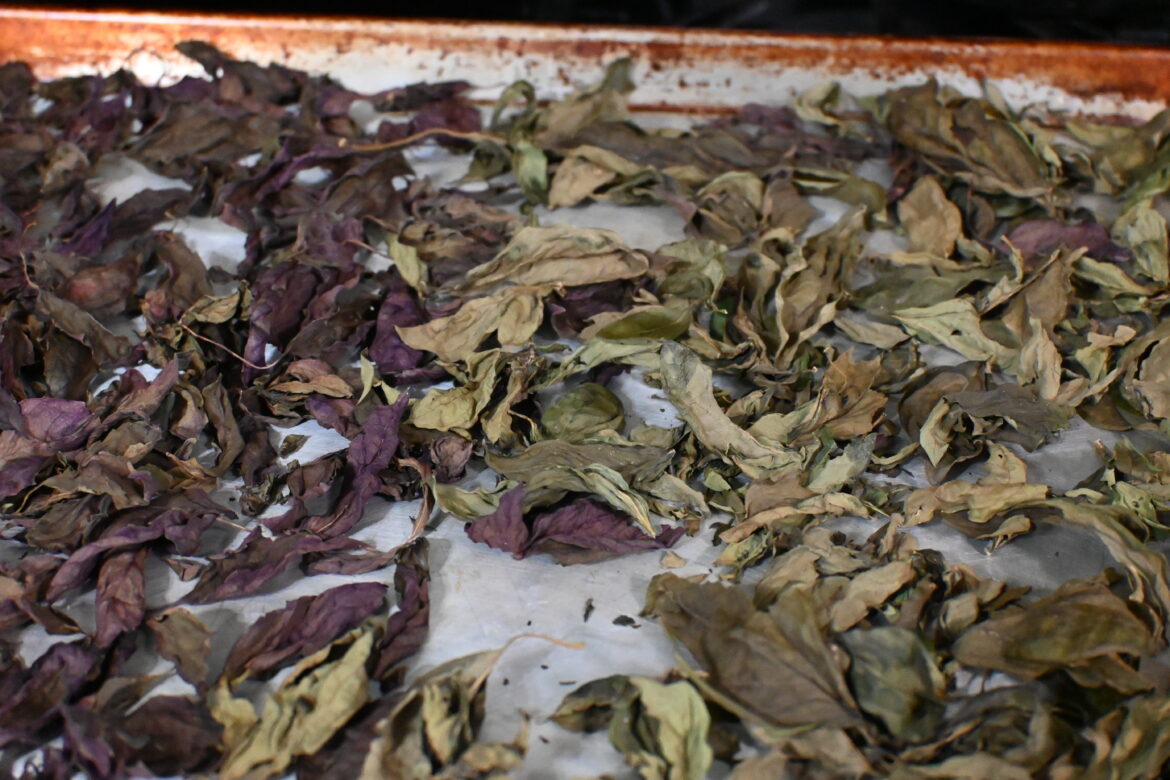I’ve not been on to have a green thumb, at least I hadn’t been. I can’t say that anymore. This year’s garden has exceeded my expectations. So much so, I have to learn new ways to harvest and save. I grew herbs every year, but they didn’t amount to very much so learning how to dry them was never on my mind.

This year I planted two Genovese Basil plants and one purple basil in my garden. I called it my Loki collection (we are big comic nerds at my house). My hope was to help bring in pollinators and color, I wasn’t expecting them to grow over two feet tall!! Yes, I grew two foot tall basil. That might not sound a lot to some, but for me it was huge.

I know I can cut the plants, tie them with the twine, and hang them upside down to dry, however I live in a very humid climate. I was concerned that not everything was going to dry quick enough to ward off bacteria growth. I don’t own a dehydrator, but I do have an oven that has a very low setting with a convection fan. To me, that is all a dehydrator is: a mini oven on a low setting with a fan blowing.
This can work with all types of herbs, not just basil. I tried this method out on marjoram, as well, and it works beautifully. Now I have to harvest the rest of the plant. And you don’t have to use your oven to dry out your herbs, there is also air drying, microwave drying, and using a dehydrator. There are a few steps you need to do prior to drying your herbs no matter which method you choose, but don’t worry I am going to walk you through them. Here we go:
Harvesting and Choosing Leaves
To ensure you preserve the best flavor and aroma of your basil, harvest fresh basil leaves in the morning before the sun has warmed them. Choose leaves that are a vibrant green color, with no signs of wilting or discoloration. Avoid leaves with holes or signs of insect damage.
Cleaning and Removing Dirt
Lay out the harvested basil leaves on a clean surface, such as a kitchen counter or cutting board. Gently remove any debris or dirt from the leaves using your fingers or a soft brush.
Washing and Drying the Leaves
- Fill a large bowl or sink with cool water, and place the basil leaves in it. Gently swish the leaves around to release any remaining dirt.
- Drain the water and repeat the process, if necessary, until the water runs clear and no dirt remains on the leaves.
- To remove excess water, you can use one of the following methods:
- Paper towels: Gently pat the basil leaves dry with clean paper towels. Be careful not to crush or bruise the leaves during the process.
- Kitchen towels: Lay the basil leaves out on a clean kitchen towel, and gently roll them up, applying light pressure to absorb the moisture. Let it sit for a few minutes.
- Salad spinner: Place the clean basil leaves in a salad spinner, and spin them gently but thoroughly to remove water.
Now that you have washed all your herbs, let’s talk about all some of the different methods of drying them.
Air Drying
The air drying method is probably the cheapest and easiest way to dry your herbs.
To do this:
- Gather small bundles of fresh basil and tie them together at the stems.
- Hang the bundles upside down in a well-ventilated room with low humidity, away from direct sunlight.
- Allow the herb leaves to air dry for approximately 2-4 weeks, until they’re crisp and easily crumble.
Microwave Drying
Microwave Drying in a microwave is a quick method, but requires close attention to prevent burning. I am not 100% convinced this doesn’t destroy the herb flavor you are drying to preserve.
To do this:
- Place a few layers of paper towels on a microwave-safe plate.
- Spread a thin layer of herb leaves on the paper towels, ensuring they don’t overlap.
- Place another layer of paper towels on top of the leaves.
- Microwave on low power (20-30%) for 1-2 minutes, checking for doneness after 1 minute.
Caution: Monitor the microwave closely to avoid burning the herb leaves.
Dehydrator
Dehydrator Drying is another great choice for drying your herb especially if you live in a humid area.
To do this.
- Spread basil leaves on dehydrator trays, making sure they don’t overlap.
- Set the temperature to around 95-105°F.
- Dry the leaves for approximately 4-6 hours, or until they’re crisp and easily crumble.

Oven Drying Process
- Preheat the Oven
- To begin the oven drying process, preheat your oven to a low temperature, around 150-170°F. A low and consistent temperature is crucial for effective drying, as it helps to remove moisture from the leaves without burning or cooking them.
- Arrange the basil leaves on baking sheets
- While the oven preheats, prepare your herb leaves for drying. Ensure there is some space between the leaves to facilitate proper air circulation during the drying process.
- Place the baking sheets with herbs in the preheated oven, making sure they don’t touch any heating elements.
- Drying herbs in the oven can take about 1-4 hours. To ensure even drying, check and rotate the baking sheets every 30 minutes. Your herbs are ready for long-term storage when they are completely dry and can easily crumble between your fingers.
- Remember, the oven drying process requires patience, but by following these steps and monitoring the temperature and time, you’re on your way to preserving your basil leaves for long-term storage.
- Tip: If your oven has a convection setting option I highly recommend using it. This will cut your drying time in half.

Preserving and Storing Dried Herbs
Let the Herbs Cool
Before storing dried basil, it is essential to let it cool down completely. This helps prevent any excess moisture from entering the airtight container, which can cause the dried basil to spoil. Wait for the basil to reach room temperature before moving on to the next step.
Store in Airtight Containers
To preserve the freshness and flavor of your dried herbs, store it in airtight containers, such as glass jars with tightly fitting lids. This will protect the dried basil from moisture, air, and contaminants. If you’re storing a large amount of dried herbs you can use smaller jars for easier access and to maintain the freshness of the unused portions.
Keep in a Dark, Cool Place
To maximize the shelf life of dried herbs, keep it in a dark, cool place away from direct sunlight or heat, as these factors can cause the herbs to lose its potency over time. A cupboard or pantry is typically a suitable location. By following these steps, you can enjoy the flavors of preserved dried basil throughout the winter months.

